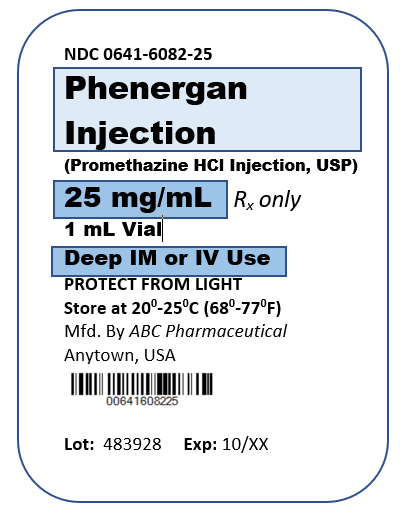5.9 Liquid Concentrations
Medications can also be supplied in liquid instead of tablets or capsules. Liquid concentrations are typically provided in milligrams (mg) per a given number of milliliters (mL). The nurse must calculate how many milliliters (mL) to administer based on the prescribed dose in milligrams (mg). Let’s practice using dimensional analysis to solve how much liquid medication to administer based on the prescription and the medication supplied.
Practice Problem: Liquid Concentrations
John Smith has been prescribed Phenergan as needed every 4-6 hours for nausea and vomiting. John is feeling nauseated and is requesting another dose of Phenergan. It has been 8 hours since the last dose was given. How many mL will you administer?
Prescription: Phenergan 12.5 mg IV PRN every 4 to 6 hours for nausea and vomiting.
Drug Supplied: See Figure 5.8[1] for an image of the label of the drug as it is supplied.

Solve this question by using dimensional analysis.
1. Start by identifying mL as the goal unit for which you are solving because you need to know how many mL of medication to administer:
![]()
2. Set up the first fraction with mL in the numerator to match the goal unit. In this problem, we know from the drug label that 1 mL contains 25 mg of medication, so plug in 1 in numerator and 25 mg in the denominator:
![]()
3. Set up the second fraction to cross out mg, so place mg in the numerator. We know from the order that the new dosage prescribed is 12.5 mg, so place 12.5 next to mg in the numerator and 1 in the denominator to cross off units:
![]()
4. Cross out mg diagonally:
![]()
5. Multiply across the numerators and denominators, and then divide the final fraction to solve the problem:
![]()
View supplementary YouTube videos on How to Use Dimensional Analysis to Calculate Oral Medication Dosages[2],[3],[4],[5]:
Review modules 1.8 and 1.9 within SWTC’s Dimensional Analysis in Nursing page for more information about solving liquid problems.
- “Phenergan Label Fig. 8.PNG” by Jody Myhre-Oechsle, Chippewa Valley Technical College, Open RN is licensed under CC BY 4.0 ↵
- Southwest Tech Math/Science Center. (2018, April 25). Entry-level drug calculations for nursing students part 2 – Pharmacology, nursing math* [Video]. YouTube. All rights reserved. Video used with permission. https://youtu.be/VHHpGeu9sNw ↵
- Southwest Tech Math/Science Center. (2018, April 25). Entry-level drug calculations for nursing students part 4 – Pharmacology, nursing math* [Video]. YouTube. All rights reserved. Video used with permission. https://youtu.be/f6bpA3usjkI ↵
- RegisteredNurseRN. (2015, February 21). Dosage calculations | Nursing drug calculations | Oral medications problems nursing school (Video 3) [Video]. YouTube. All rights reserved. Video used with permission. https://youtu.be/zZ3M747ChrQ ↵
- RegisteredNurseRN. (2018, April 25). Weight-based calculations | Drug medication calculations by weight nursing students (Video 6) [Video]. YouTube. All rights reserved. Video used with permission. https://youtu.be/F_LfMcRT8aY ↵

